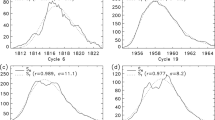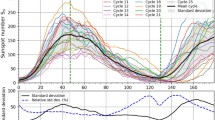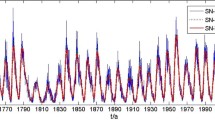Abstract
A number of precursor-type methods for solar-cycle prediction are based on the use of regression models and confidence-level estimates. A drawback of these methods is that they do not permit one to make probability statements, nor do they offer straightforward ways to propagate the uncertainty from observations to the quantities of interest. We suggest a method for calculating the probability of the maximum amplitude of Solar Cycle 25 using Bayesian inference. We illustrate this approach with the predictions made by one particular phenomenological model that relates the time interval between the termination events of preceding cycles to the amplitude of the next cycle. Our results show well-constrained posterior-predictive distributions for the maximum sunspot number. The impact of uncertainty on the sunspot number and the time interval between terminators is quantified. A comparison between the maximum sunspot numbers of the past and the posterior-predictive distributions computed using the method enables us to quantify the quality of the inference and the prediction.



Similar content being viewed by others
Data Availability
The datasets generated during and/or analysed during the current study are available from the corresponding author on reasonable request.
Notes
The official NOAA press release with the Panel’s forecast can be found at www.weather.gov/news/190504-sun-activity-in-solar-cycle.
References
Carrasco, V.M.S., Vaquero, J.M.: 2021, Solar Cycle 25 is currently very similar to Solar Cycle 24. Res. Notes Amer. Astron. Soc. 5, 181. DOI. ADS.
Clette, F., Svalgaard, L., Vaquero, J.M., Cliver, E.W.: 2014, Revisiting the sunspot number. A 400-year perspective on the solar cycle. Space Sci. Rev. 186, 35. DOI. ADS.
D’Agostini, G.: 2003, Bayesian Reasoning in Data Analysis, World Scientific, Singapore. DOI.
Dudok de Wit, T., Lefèvre, L., Clette, F.: 2016, Uncertainties in the sunspot numbers: estimation and implications. Solar Phys. 291, 2709. DOI. ADS.
Gregory, P.C.: 2005, Bayesian Logical Data Analysis for the Physical Sciences: A Comparative Approach with Mathematica® Support, Cambridge University Press, Cambridge. DOI. ISBN 9780521841504. ADS.
Harris, C.R., Millman, K.J., van der Walt, S.J., Gommers, R., Virtanen, P., Cournapeau, D., Wieser, E., Taylor, J., Berg, S., Smith, N.J., Kern, R., Picus, M., Hoyer, S., van Kerkwijk, M.H., Brett, M., Haldane, A., del Río, J.F., Wiebe, M., Peterson, P., Gérard-Marchant, P., Sheppard, K., Reddy, T., Weckesser, W., Abbasi, H., Gohlke, C., Oliphant, T.E.: 2020, Array programming with NumPy. Nature 585, 357. DOI. ADS.
Hathaway, D.H.: 2015, The solar cycle. Liv. Rev. Solar Phys. 12, 4. DOI. ADS.
Hunter, J.D.: 2007, Matplotlib: a 2D graphics environment. Comput. Sci. Eng. 9, 90. DOI. ADS.
Jaynes, E.T.: 2003, Probability Theory: The Logic of Science, Cambridge University Press, Cambridge. DOI. ISBN 9780511790423.
Leamon, R.J., McIntosh, S.W., Chapman, S.C., Watkins, N.W.: 2020, Timing terminators: forecasting sunspot cycle 25 onset. Solar Phys. 295, 36. DOI. ADS.
Leamon, R.J., McIntosh, S.W., Chapman, S.C., Watkins, N.W.: 2021, Response to “Limitations in the Hilbert transform approach to locating solar cycle terminators” by R. Booth. Solar Phys. 296, 151. DOI. ADS.
Lindley, D.V.: 2014, Understanding Uncertainty, Wiley, Hoboken. DOI. ISBN 9781118650158.
Mathieu, S., von Sachs, R., Ritter, C., Delouille, V., Lefèvre, L.: 2019, Uncertainty quantification in sunspot counts. Astrophys. J. 886, 7. DOI. ADS.
McIntosh, S.W., Chapman, S., Leamon, R.J., Egeland, R., Watkins, N.W.: 2020, Overlapping magnetic activity cycles and the sunspot number: forecasting sunspot cycle 25 amplitude. Solar Phys. 295, 163. DOI. ADS.
Morey, R.D., Hoekstra, R., Rouder, J.N., Lee, M.D., Wagenmakers, E.-J.: 2016, The fallacy of placing confidence in confidence intervals. Psychon. Bull. Rev. 23, 103. DOI.
Muñoz-Jaramillo, A., Vaquero, J.M.: 2019, Visualization of the challenges and limitations of the long-term sunspot number record. Nat. Astron. 3, 205. DOI. ADS.
Nandy, D.: 2021, Progress in solar cycle predictions: sunspot cycles 24 – 25 in perspective. Solar Phys. 296, 54. DOI. ADS.
Neyman, J.: 1937, Outline of a theory of statistical estimation based on the classical theory of probability. Phil. Trans. Roy. Soc. London Ser. A, Math. Phys. Sci. 236, 333. DOI. ADS.
Pesnell, W.D.: 2018, Effects of version 2 of the international sunspot number on naïve predictions of Solar Cycle 25. Space Weather 16, 1997. DOI.
Petrovay, K.: 2020, Solar cycle prediction. Liv. Rev. Solar Phys. 17, 2. DOI. ADS.
von Toussaint, U.: 2011, Bayesian inference in physics. Rev. Mod. Phys. 83, 943. DOI.
Acknowledgements
I thank the reviewer for constructive and insightful comments and suggestions. I am indebted to Scott W. Mcintosh for the correspondence that motivated this study. I am grateful to Andrés Asensio Ramos, José Manuel Vaquero, and Víctor Manuel Sánchez Carrasco for helpful comments and suggestions. Calculations and figures were implemented with numpy (Harris et al., 2020) and matplotlib (Hunter, 2007).
Funding
This research was supported by project PGC2018-102108-B-I00 from Ministerio de Ciencia, Innovación y Universidades and FEDER funds.
Author information
Authors and Affiliations
Corresponding author
Ethics declarations
Disclosure of Potential Conflicts of Interest
The author declares that there is no conflict of interest.
Additional information
Publisher’s Note
Springer Nature remains neutral with regard to jurisdictional claims in published maps and institutional affiliations.
Appendix: Uncertainty Analysis
Appendix: Uncertainty Analysis
The uncertainty on the computed posterior-predictive distribution depends on the uncertainty of the sunspot number [\(\sigma _{\mathrm{SSN}}\)] and the time interval between termination events [\(\sigma _{\Delta T}\)]. These two quantities determine the shape and dispersion of the likelihood functions in Equations 4 and 7. Their possible values hence have an impact on the inferred posterior for \(\alpha \) and \(\beta \) and the subsequent posterior-predictive distribution \(p(\mathrm{SSN_{25}}|\mathcal{D}, \mathcal{M})\). The uncertainty about the sunspot number is the subject to intense continuous investigation (see, e.g., Clette et al., 2014; Dudok de Wit, Lefèvre, and Clette, 2016; Muñoz-Jaramillo and Vaquero, 2019; Mathieu et al., 2019). The uncertainty in the time interval between terminator events needs to be quantified. Their relative dominance is important to quantify the uncertainty of our predictions.
Let us consider the approximate formula \(\sigma _{\mathrm{SSN}}=1.7\sqrt{\mathrm{SSN}+1}\) from Dudok de Wit, Lefèvre, and Clette (2016) for the uncertainty in sunspot-number data. The top panel of Figure 4 shows how the marginal posterior for the slope of the inferred model depends on different values for the uncertainty of the time interval between termination events [\(\sigma _{\Delta T}\)]. As \(\sigma _{\Delta T}\) increases, the distribution initially moves towards the left and then towards the right. The distribution also becomes non-symmetric and has a larger dispersion. A similar effect is observed in the marginal posterior for the intercept [\(\beta \)], which is not shown here. The middle panel of Figure 4 shows the corresponding solutions for the posterior-predictive distribution for Solar Cycle 25. Now, the distribution first slightly shifts towards the right and then towards the left, as already mentioned for the case with \(\sigma _{\mathrm{SSN}}=10\) (see Figure 2). The uncertainty of the solution also increases with increasing \(\sigma _{\Delta T}\).
Top: Marginal posterior density for the slope \(\alpha \) for inferences with \(\sigma _{\mathrm{SSN}} = 1.7\sqrt{\mathrm{SSN} +1}\) and different values for the uncertainty of the time interval between termination events \(\sigma _{\Delta T}\). Middle: Corresponding posterior-predictive distributions for Solar Cycle 25. Bottom: Variation of the total uncertainty [\(\sigma ^{2}\)] and of each contribution [\(\sigma ^{2}_{ \mathrm{SSN}}\) and \(\alpha ^{2}\sigma ^{2}_{\Delta T}\)] in the likelihood functions Equations 4 and 7 used in the inference and subsequent prediction.
This behaviour is closely linked to the relative dominance of the two sources of uncertainty in the inference and prediction processes. This is shown in the bottom panel of Figure 4. When the uncertainty in the time interval between termination events is negligible or relatively small, the full uncertainty of the inference [\(\sigma ^{2}\)] is determined by the uncertainty in the sunspot number. As we increase the uncertainty for \(\Delta T\), the total uncertainty increases, thus the posteriors widen, and at the same time slightly shift. At a given moment, for \(\sigma _{\Delta T} \approx \) 0.8, both uncertainties contribute equally to the total uncertainty. From then on, the uncertainty for \(\Delta T\) dominates and the posteriors move in the opposite direction while becoming more asymmetric. With an error in the estimate of the time interval between events below \(\approx 0.5\) years, the uncertainty of the problem is predominantly determined by the uncertainty of the sunspot number.
Rights and permissions
About this article
Cite this article
Arregui, I. Methodology for Predicting the Probability Distribution of the Amplitude of Solar Cycle 25. Sol Phys 297, 21 (2022). https://doi.org/10.1007/s11207-022-01960-3
Received:
Accepted:
Published:
DOI: https://doi.org/10.1007/s11207-022-01960-3





